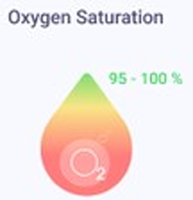Oxygen Saturation, or SpO2, is a measure of how much oxygen the red blood cells are carrying from the lungs to the rest of the body. Normal SpO2 for healthy lungs ranges between 95%-100%. For individuals with chronic conditions or lung diseases could be lower than 95%.

A low level of oxygen in the blood is called hypoxemia. Typically, an Oxygen Saturation level lower than 90% is considered hypoxemia, which can be caused by chronic pulmonary diseases (COPD, COVID-19, Asthma, Lung Fibrosis, pulmonary hypertension), heart failure, sleep apnea, anemia, and high-altitude exposure (insufficient oxygen in the air) and medications that suppress breathing control.
Common symptoms of hypoxemia include headache, rapid heart rate, coughing, shortness of breath, wheezing, confusion, and blueness of the skin and mucus membranes (cyanosis). Oxygen Saturation levels can also be used by athletes to understand whether a decrease in performance is a result of altitude changes or ability.
If you feel that your oxygen Saturation is low, speak to a doctor about your symptoms. They will let you know what is normal for your specific condition. |